family

 It so hard for me to believe that my niece, Jessi Sawdon is celebrating her 40th birthday. I remember the day she was born. She was such a cutie, and as he grew, her personality shown through. Jessi is the firstborn of my sister, Allyn Hadlock and her husband, Chris Hadlock’s four children. Jessi is a very social person, and for her, every day is a celebration…and Jessi does love to celebrate!! Her sister, Lindsay says, “She’s a good aunt. Mackenzie always has fun when we go over there or if she goes to stay the night. She’s has really settled in Cheyenne…finding a great church, making some new friends, and getting into a rhythm. She’s gotten really involved in her church and her family has been growing spiritually.” Lindsay and her family live in Laramie, Wyoming, which is a little over half an hour drive from Jessi and her family in Cheyenne, Wyoming. The closeness has made it possible for Lindsay’s daughter, Mackenzie and Jessi’s daughter, Adelaide to be really good friends, and for Jessi and Lindsay to be close sisters too.
It so hard for me to believe that my niece, Jessi Sawdon is celebrating her 40th birthday. I remember the day she was born. She was such a cutie, and as he grew, her personality shown through. Jessi is the firstborn of my sister, Allyn Hadlock and her husband, Chris Hadlock’s four children. Jessi is a very social person, and for her, every day is a celebration…and Jessi does love to celebrate!! Her sister, Lindsay says, “She’s a good aunt. Mackenzie always has fun when we go over there or if she goes to stay the night. She’s has really settled in Cheyenne…finding a great church, making some new friends, and getting into a rhythm. She’s gotten really involved in her church and her family has been growing spiritually.” Lindsay and her family live in Laramie, Wyoming, which is a little over half an hour drive from Jessi and her family in Cheyenne, Wyoming. The closeness has made it possible for Lindsay’s daughter, Mackenzie and Jessi’s daughter, Adelaide to be really good friends, and for Jessi and Lindsay to be close sisters too.
For my sister, Allyn, this birthday has been one of reflection. Allyn says, “Jessi celebrated her 40th this year!! 
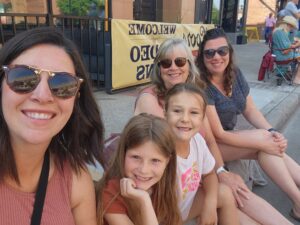 Looking back over the years, I see how fun and smart and strong she is!! ‘Girls just wanna have fun’ really describes her!! She is a good wife and a terrific mother. She loves to be on the move, going camping, to museums, hiking, any downtown activities, she’s all about it. This year she wanted to celebrate as much as she could so her, and a bunch of friends went out to Napa California and toured some wineries, stayed in an air BNB, and really had a great time. They sat in the hot tub, toured the golden gate bridge area, and one of the girls had an aunt and uncle who live out there and they gave the girls the royal treatment with an all-day cruise around San Francisco Bay in their yacht! They fed them breakfast and lunch on the boat and Jessi says it was definitely a highlight of their trip. They were so kind and really made it special for the girls!!”
Looking back over the years, I see how fun and smart and strong she is!! ‘Girls just wanna have fun’ really describes her!! She is a good wife and a terrific mother. She loves to be on the move, going camping, to museums, hiking, any downtown activities, she’s all about it. This year she wanted to celebrate as much as she could so her, and a bunch of friends went out to Napa California and toured some wineries, stayed in an air BNB, and really had a great time. They sat in the hot tub, toured the golden gate bridge area, and one of the girls had an aunt and uncle who live out there and they gave the girls the royal treatment with an all-day cruise around San Francisco Bay in their yacht! They fed them breakfast and lunch on the boat and Jessi says it was definitely a highlight of their trip. They were so kind and really made it special for the girls!!”
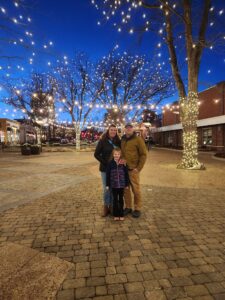
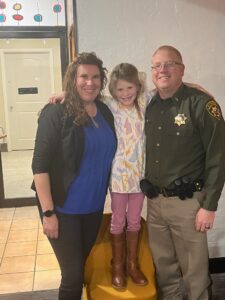
Then, her husband, Jason threw her 40th birthday party out at the Hangar, in Casper, Wyoming, and we celebrated her all evening. Allyn and Chris helped him plan the party, and it really turned out nice. Last Thursday, they were back in town for Jessi’s company Christmas party, and we gave her a birthday dinner here on Friday night with grilled steak, potatoes, and roasted veggies. Allyn really hopes she had the 40th year of her dreams, and she knows the fun will continue because “she just wants to have fun!!” Truer words were never spoken. Jessi is a fun-loving person and always put a smile on your face. Today is Jessi’s 40th birthday!! Happy birthday Jessi!! Have a great day!! We love you!!
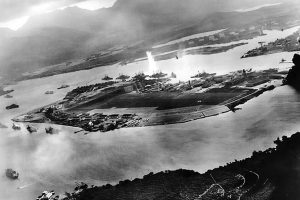
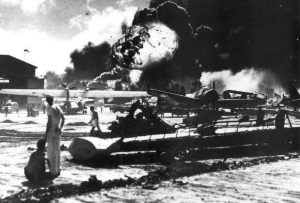 The 83rd anniversary of Pearl Harbor, at least for the Baby Boomer generation and older, prompts reflection on the United States’ stance of often waiting for an initial attack before responding. While this is not always the case, it appears to be a common scenario. The US strives to act as a peacemaker, and the decision to go to war is never taken lightly due to the grave consequences of taking lives. Typically, numerous warnings are issued before any action is taken, and frequently, it’s too late to preemptively strike. The first to strike is often labeled the aggressor, but there are times when ample warning signals an imminent attack, yet the response is still delayed, until the attack occurs, resulting in loss of life and leaving the survivors to deal with the aftermath rather than considering an immediate counterstrike. Of course, the reverse is hard to deal with too, because we would come off as being the aggressor, and that just isn’t our style.
The 83rd anniversary of Pearl Harbor, at least for the Baby Boomer generation and older, prompts reflection on the United States’ stance of often waiting for an initial attack before responding. While this is not always the case, it appears to be a common scenario. The US strives to act as a peacemaker, and the decision to go to war is never taken lightly due to the grave consequences of taking lives. Typically, numerous warnings are issued before any action is taken, and frequently, it’s too late to preemptively strike. The first to strike is often labeled the aggressor, but there are times when ample warning signals an imminent attack, yet the response is still delayed, until the attack occurs, resulting in loss of life and leaving the survivors to deal with the aftermath rather than considering an immediate counterstrike. Of course, the reverse is hard to deal with too, because we would come off as being the aggressor, and that just isn’t our style.
On December 7, 1941, the United States found itself in a precarious position. Despite repeatedly warning Japan, the United States using the Hull Note as a show of the ultimate caution, tried to avoid entering World War II. The Hull Note officially the Outline of Proposed Basis for Agreement Between the United States and Japan, was the final proposal delivered to the Empire of Japan by the United States of America before the attack on Pearl Harbor (December 7, 1941) and the Japanese declaration of war (seven and a half hours after the attack began). Unfortunately, Japan to all that as a show of weakness. Nevertheless, knowing that Japan would likely not comply, and essentially declaring war, the US still hoped they would proceed slowly, perhaps 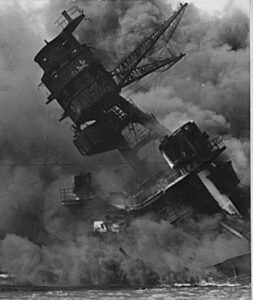 even reconsider their course. Conversely, Japan acted swiftly, dispatching their strike force towards Pearl Harbor and simultaneously sending a decoy towards Thailand to mislead the US. Then, believing an attack on Thailand was imminent, President Roosevelt implored Emperor Hirohito via telegram to act “for the sake of humanity” and prevent further devastation. The US endeavored to maintain peace.
even reconsider their course. Conversely, Japan acted swiftly, dispatching their strike force towards Pearl Harbor and simultaneously sending a decoy towards Thailand to mislead the US. Then, believing an attack on Thailand was imminent, President Roosevelt implored Emperor Hirohito via telegram to act “for the sake of humanity” and prevent further devastation. The US endeavored to maintain peace.
After transmitting the telegram, President Roosevelt was working on his stamp collection alongside his personal advisor, Harry Hopkins. They deliberated over Japan’s rejection of the Hull Note. Hopkins proposed a preemptive strike by America, but President Roosevelt maintained that it was not an option. Unbeknownst to them, it was already too late for a first strike…time had run out. The Japanese forces were en route to Pearl Harbor, where a significant segment of the Pacific Fleet lay anchored, vulnerable to attack. The impending ambush would devastate 18 US ships, including the Arizona, Virginia, California, Nevada, and West Virginia, either destroyed, sunk, or capsized. Over 180 aircraft were destroyed on the ground, with an additional 150 damaged, leaving a mere 43 operational. American casualties exceeded 3,400, with over 2,400 fatalities—1,000 of which occurred on the Arizona alone. The Japanese incurred fewer than 100 losses.
It often appears that the party who strikes first, swiftly and with the element of surprise, ultimately fares better. The side caught off guard, or the one that ignored the warning signs, is usually defeated. With one of the strongest military forces on Earth, America should not be taken by surprise. I believe that overconfidence in one’s strength, leading to a lack of vigilance, can result in the downfall of even the mightiest. The United States has been such a force, but our reluctance to preemptively strike seems to invite repeated attacks without warning. It is only after such attacks that we seem to retaliate.
It’s indeed a dilemma, perhaps reflective of President Roosevelt’s perspective. If we strike first, we’re vilified globally as the aggressors, akin to those at Pearl Harbor. If we don’t, we face condemnation from our own citizens. Moreover, our intelligence isn’t infallible, leading to situations like the surprise attack on December 7th, 1941, when we expected honor from an adversary who did not feel bound by it. It seems that although being 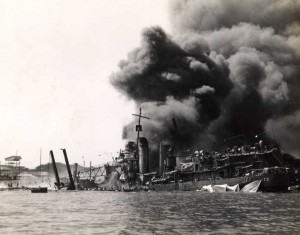
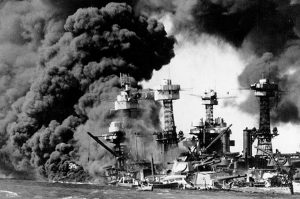 attacked unprovoked is undesirable, we must still act honorably and not launch a preemptive strike merely based on anticipated aggression. Otherwise, we become indistinguishable from those nations we confront in war for their acts of invasion. Nevertheless, it remains a huge challenge to always be the nation that does the right things, especially when there is a profound mistrust of our enemies…because we know better.
attacked unprovoked is undesirable, we must still act honorably and not launch a preemptive strike merely based on anticipated aggression. Otherwise, we become indistinguishable from those nations we confront in war for their acts of invasion. Nevertheless, it remains a huge challenge to always be the nation that does the right things, especially when there is a profound mistrust of our enemies…because we know better.
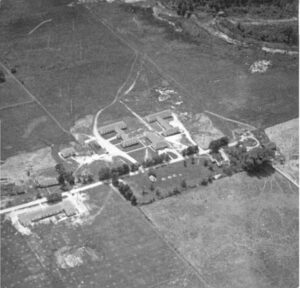
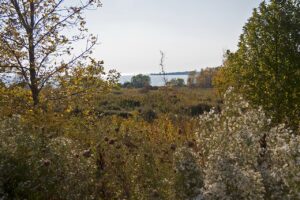 On the shores of Lake Ontario between Whitby and Oshawa is an area now known as Intrepid Park, but that wasn’t always its name, and in was now just an innocent park then either. Today, in fact, few remnants suggest the fascinating history of the site. During the World War II, it served as Camp X, the clandestine intelligence and espionage training center for the Allies. Officially designated as Secret Training Center 103, with the informal designation, Camp X, the site fully captures the top-secret essence of its operations. The site is currently recognized as Intrepid Park, named in honor of Sir William Stephenson’s codename Intrepid. Stephenson was the Director of British Security Coordination (BSC) who was responsible for founding the training center.
On the shores of Lake Ontario between Whitby and Oshawa is an area now known as Intrepid Park, but that wasn’t always its name, and in was now just an innocent park then either. Today, in fact, few remnants suggest the fascinating history of the site. During the World War II, it served as Camp X, the clandestine intelligence and espionage training center for the Allies. Officially designated as Secret Training Center 103, with the informal designation, Camp X, the site fully captures the top-secret essence of its operations. The site is currently recognized as Intrepid Park, named in honor of Sir William Stephenson’s codename Intrepid. Stephenson was the Director of British Security Coordination (BSC) who was responsible for founding the training center. 
The facility was a collaborative effort involving the Canadian military, with support from Foreign Affairs and the RCMP, and was commanded by the BSC. It also had strong links with MI6. While the United States was officially neutral at that time, the camp aimed to strengthen ties between the US and Great Britain. The camp boasted a communications tower called Hydra, which was equipped to send and transmit radio and telegraph messages. The camp officially opened on December 6, 1941, and with the Pearl Harbor attack the next day, the US abandoned its stance of neutrality and actively participated in the war, including the training of troops at Camp X.
The camp provided training in diverse skills such as sabotage, subversion, intelligence gathering, lock picking, explosives handling, radio operation, code encryption/decryption, partisan recruitment, silent killing, and hand-to-hand combat. Trainees also learned communication methods, including Morse code. The camp was shrouded in such secrecy that even the Canadian Prime Minister, William Lyon Mackenzie King, did not completely understand its purpose. Reports indicate that graduates worked as “secret agents, security personnel, intelligence officers, or psychological warfare experts, serving in clandestine operations. Many were captured, 
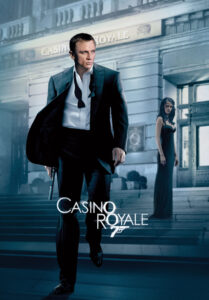 tortured, and executed; survivors received no individual recognition for their efforts.” The facility was in operation throughout World War II. The training facility ceased operations before the end of 1944. By 1969, the buildings were dismantled, and a monument placed there.
tortured, and executed; survivors received no individual recognition for their efforts.” The facility was in operation throughout World War II. The training facility ceased operations before the end of 1944. By 1969, the buildings were dismantled, and a monument placed there.
Apparently, Ian Flemming visited or was trained at Camp X, because it is said that he used the site as a model for his training facility on the “007” series of movies. Fleming worked in intelligence most of his naval career. In fact, much of the background to the stories came from Fleming’s previous work in the Naval Intelligence Division or from events he knew of from the Cold War. His work there is very likely what made those movies so believable.
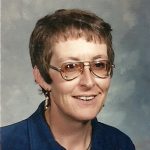
 Our aunt, Linda Cole was always a vibrant, happy person. She had a laugh that would light up a room. We didn’t see Linda and her husband Bobby as much as some of the rest of the family, because they lived for many years is Kennebec, South Dakota, where they owned a little “mom and pop” hotel. To visit them and their children, Sheila and Pat meant a trip of at least a weekend, and better yet a three or four day weekend. The drive was long enough to where you had to stay the night. The nice thing was that since they owned a hotel, you always had a place to stay…and they never would let us pay them for the room. They just liked that we wanted to come for a visit at least once a year.
Our aunt, Linda Cole was always a vibrant, happy person. She had a laugh that would light up a room. We didn’t see Linda and her husband Bobby as much as some of the rest of the family, because they lived for many years is Kennebec, South Dakota, where they owned a little “mom and pop” hotel. To visit them and their children, Sheila and Pat meant a trip of at least a weekend, and better yet a three or four day weekend. The drive was long enough to where you had to stay the night. The nice thing was that since they owned a hotel, you always had a place to stay…and they never would let us pay them for the room. They just liked that we wanted to come for a visit at least once a year.
When the hotel burned down, after being struck by lightning, they pretty much lost their livelihood. To rebuild made no sense, because there was a chain motel that was right off the interstate, meaning that fewer people actually came into Kennebec to the “mom and pop” that was located there. Times were changing, and they would have to change with them. The solution was a move to Winnemucca, Nevada, where they found jobs working in the casinos. I think they were happy to be free of the hotel, because it meant no more cleaning rooms and limiting their vacation times to the months when no one was traveling, including them. Winters in South Dakota can be a special kind of brutal, and travel was hazardous. Linda and Bobby found that the warmer, dryer climate of Nevada really suited them, so they stayed for the rest of their lives. They never “struck it rich” but they had a good time. Their move to Nevada meant that fewer people went for visits, and that is sad. It was a little further, so it was hard. Her sister, Joann and brother-in-law visited the most.
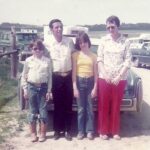
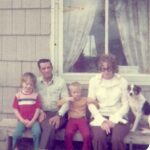 Bobby passed away from cancer on May 30, 2014, at the age of 71, and Linda passed away unexpectantly on September 22, 2016, from a heart attack at the age of 69. We were shocked and saddened by their passing. They were, in my opinion, far too young. I think Linda lost the will to live after Bobby passed. They were such a part of each other. Their marriage was on that was made in Heaven, and they never doubted their love for each other for a minute. Today would have been Linda’s 78th birthday. Happy birthday in Heaven, Linda. We love and miss you very much.
Bobby passed away from cancer on May 30, 2014, at the age of 71, and Linda passed away unexpectantly on September 22, 2016, from a heart attack at the age of 69. We were shocked and saddened by their passing. They were, in my opinion, far too young. I think Linda lost the will to live after Bobby passed. They were such a part of each other. Their marriage was on that was made in Heaven, and they never doubted their love for each other for a minute. Today would have been Linda’s 78th birthday. Happy birthday in Heaven, Linda. We love and miss you very much.
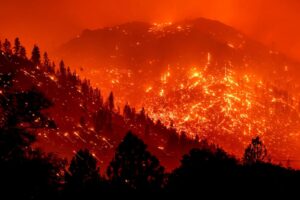
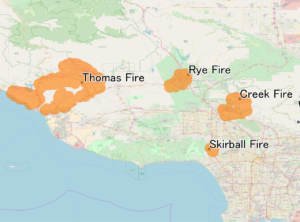 We all know that California is prone to wildfires. The hot Santa Ana winds stir up trouble every single year. Some years are worse than others due to dryer conditions. The year 2017 was one of those years. That year, in December, a series of 29 wildfires broke out across Southern California. Six of these fires escalated into major incidents, prompting extensive evacuations and significant property damage. The fires collectively incinerated more than 307,900 acres, leading to traffic jams, school shutdowns, dangerous air quality, and electricity blackouts, with over 230,000 individuals forced to evacuate. The Thomas Fire quickly grew to 281,893 acres, setting the record as the largest wildfire in contemporary California history, a record that stood until the Ranch Fire in the Mendocino Complex exceeded it the next year.
We all know that California is prone to wildfires. The hot Santa Ana winds stir up trouble every single year. Some years are worse than others due to dryer conditions. The year 2017 was one of those years. That year, in December, a series of 29 wildfires broke out across Southern California. Six of these fires escalated into major incidents, prompting extensive evacuations and significant property damage. The fires collectively incinerated more than 307,900 acres, leading to traffic jams, school shutdowns, dangerous air quality, and electricity blackouts, with over 230,000 individuals forced to evacuate. The Thomas Fire quickly grew to 281,893 acres, setting the record as the largest wildfire in contemporary California history, a record that stood until the Ranch Fire in the Mendocino Complex exceeded it the next year.
On December 5th, Governor Jerry Brown declared a state of emergency for Ventura and Los Angeles Counties, followed by San Diego County on December 7th. President Donald Trump went on to declare a State of Emergency for California on December 8th. The situation was already heading for a disaster, and these resources were going to be badly needed. The swarm of wildfires was intensified by exceptionally strong and persistent Santa Ana winds, coupled with abundant dry vegetation due to an unusually parched rainy season to that date. These fires also marked the culmination of an extraordinarily active and damaging wildfire season, resulting in at least $3.5 billion in damages, as well as, $2.2 billion in insured losses and $300 million in fire suppression expenses.
The initial report of the fire came in at 6:26pm on December 4th, just north of Santa Paula, close to Steckel Park and Thomas Aquinas College. The winds quickly pushed the blaze until it covered 12 miles of rural terrain into Ventura city. Within a few hours, it had destroyed nearly 500 homes, engulfing 50,000 acres. In the following days, it progressed toward Ojai, crossing Highway 33 and the Ventura River, reaching the Rincon Oil Field area. By December 8th, the Thomas Fire had expanded to 143,000 acres, with containment at only 10%, and the cost of battling the blaze was estimated to be at least $17 million. By the evening of December 10th, the Thomas Fire had expanded to 230,000 acres, now ranking as the fifth-largest wildfire in the modern history of California and the largest to occur in the state during December. It was moving so fast…at times, spreading at a rate exceeding one acre per second. It destroyed a minimum of 794 structures, damaged another 187, and incurred a fighting cost of at least $38.4 million, placing it among the top ten most destructive wildfires in California’s history. By the early hours of December 11th, the Thomas Fire had increased to 230,500 acres, with containment efforts reaching 15%. On December 13th, the Thomas Fire’s northwestern and southwestern flanks merged east of Carpinteria, covering an area that includes Ojai and Lake Casitas. By the early hours of December 16th, the fire had grown to 259,000 acres, with 40% containment, now overtaking the Rim Fire as the third-largest wildfire in California’s history. By December 19th, the Thomas Fire had expanded to 272,000 acres, with 55% containment, becoming the second-largest wildfire in the state’s modern history. On the evening of December 22nd, the Thomas Fire grew to 273,400 acres, reaching 65% containment and surpassing the Cedar Fire of 2003, making it California’s largest recorded wildfire. By December 24th, the fire had expanded to 281,620 acres, which was largely due to a back-burning operation merging into the fire’s northwestern flank, although the containment of the fire also rose to 86%.
Then, on January 8–9, 2018, what might have seemed like blessing…a winter storm hit California, causing heavy rainfall in Southern California and leading to mandatory evacuations in parts of Los Angeles, Santa Barbara, and Ventura Counties due to the risk of mudslides in wildfire-affected areas. The storm resulted in at least four inches of rain, triggering numerous significant mudflows. On January 12, 2018, the US Forest Service announced that the Thomas Fire was 100 percent contained, covering 281,893 acres. Nevertheless, officials from Los Padres National Forest kept watch over the Thomas Fire’s burn area for any remaining hotspots. By March 22, 2018, InciWeb reported the Thomas Fire as inactive and stopped updates. Nevertheless, they kept a vigil, before finally, officially declaring the fire extinguished on June 1, 2018, following over two months without any detected hotspots within the burn area’s boundaries.
In addition to the Thomas fire, 28 other fires raged across the area during that period. Causes of the fires varied, from lightning to illegal cook fires to arson. Roads and interstates had to be closed, and areas evacuated. The wildfires of December 2017 devastated vast tracts of land, leading to significant property damage. Moreover, they compelled the evacuation of over 230,000 residents from their homes. The Thomas Fire claimed the lives of two individuals: Virginia Pesola, a 70-year-old civilian from Santa Paula, and Cory Iverson, a firefighter engaged in combatting the blaze. “This is a tragic reminder of the dangerous work that our firefighters do every day,” stated Teresa Benson, Los Padres National Forest Supervisor, in a press release. “The Thomas Fire presents many unprecedented conditions and complexities, adding to the already challenging task of fire suppression.” The wildfires led to the destruction of vast areas of forest. The absence of tree roots, which normally help bind the soil, resulted in decreased ground stability, making the terrain susceptible to 
 mudslides during heavy rainfall. In early January 2018, forecasts of significant rain for the American Southwest prompted the issuance of flash flood warnings and evacuation orders for parts of California that were impacted by the wildfires. In all 45 civilians and 2 firefighters lost their lives in these 29 fires. In addition, 199 civilians and 12 firefighters were injured, and 10,280 structures were destroyed.
mudslides during heavy rainfall. In early January 2018, forecasts of significant rain for the American Southwest prompted the issuance of flash flood warnings and evacuation orders for parts of California that were impacted by the wildfires. In all 45 civilians and 2 firefighters lost their lives in these 29 fires. In addition, 199 civilians and 12 firefighters were injured, and 10,280 structures were destroyed.
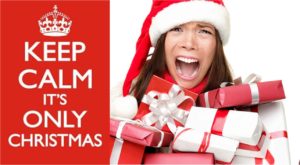 There are some years when it just seems like the holidays get ahead of you and you find yourself playing catch-up all the way to Christmas. This has been one of those years…with a little bit of a twist. This year, Thanksgiving fell very late in the month…November 28th. Of course, Thanksgiving is always the fourth Thursday in November, so that means that the earliest it can be in the 22nd and the latest is the 28th. So, this year it was the 28th, and for some reason, it felt like Thanksgiving would never arrive. I kept thinking that it should have been here two weeks earlier. Then, when it finally arrived, it felt like Christmas was…tomorrow!! Suddenly, it hit me that I had a lot to do to get ready for Christmas. It felt like all the shopping days were coming to an end, and I wasn’t even remotely ready. I felt like I was going to panic.
There are some years when it just seems like the holidays get ahead of you and you find yourself playing catch-up all the way to Christmas. This has been one of those years…with a little bit of a twist. This year, Thanksgiving fell very late in the month…November 28th. Of course, Thanksgiving is always the fourth Thursday in November, so that means that the earliest it can be in the 22nd and the latest is the 28th. So, this year it was the 28th, and for some reason, it felt like Thanksgiving would never arrive. I kept thinking that it should have been here two weeks earlier. Then, when it finally arrived, it felt like Christmas was…tomorrow!! Suddenly, it hit me that I had a lot to do to get ready for Christmas. It felt like all the shopping days were coming to an end, and I wasn’t even remotely ready. I felt like I was going to panic.
Then, there were the upcoming parties and decorating the house, planning the upcoming party meals, timing for gatherings, and well, lots more. It is the season for all the hustle and bustle, the shopping, and all the makings of the Christmas season. Whether we are preparing for the celebrations, shopping, or cooking, this is the busiest season of the year. That can mean lots of stress, and that can be difficult to manage. Of course, when the day finally arrives, and Christmas is finally here, we always seem to be able to set all that anxiety aside and enjoy the time with our loving families…at least once dinner is on the table.
I’m not sure why this year hit me that way, but I don’t think I’m alone in it. I know several people who have 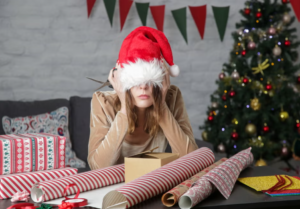 put their Christmas decorations up later than normal, unless they are like my granddaughter, Shai Royce, who had her tree and decorations up before Halloween. I don’t know how she does it. I was in no way prepared then. Then when I did get ready, we had an “epic fail” when the tree was up and we put the lights on and only one string worked. We had been planning to buy a new pre-lit tree for next year, but we couldn’t see buying a string of lights we wouldn’t need next year. So, we bought a new tree…and no, the tree isn’t completely decorated yet. I’m still running very behind on things this year, but whether we are behind or not, Christmas will arrive, right on time, December 25th. One way or the other, ’tis the season, and we will participate.
put their Christmas decorations up later than normal, unless they are like my granddaughter, Shai Royce, who had her tree and decorations up before Halloween. I don’t know how she does it. I was in no way prepared then. Then when I did get ready, we had an “epic fail” when the tree was up and we put the lights on and only one string worked. We had been planning to buy a new pre-lit tree for next year, but we couldn’t see buying a string of lights we wouldn’t need next year. So, we bought a new tree…and no, the tree isn’t completely decorated yet. I’m still running very behind on things this year, but whether we are behind or not, Christmas will arrive, right on time, December 25th. One way or the other, ’tis the season, and we will participate.
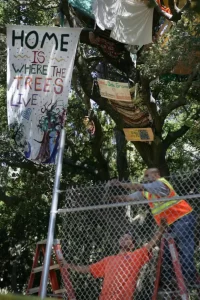 Sometimes, people are so serious about their cause, that they decide to stage a sit-in. Sometimes that, in itself, can become extreme. Such was the case when four students at the University of California, Berkeley, decided to occupy the treetops of an oak grove on campus on December 2, 2006. They were there to show their opposition to the university’s intention to clear more than an acre of forest for a new athletic center, sparking an epic 21-month standoff. This event marked one of the longest tree sit-ins in historical record. When I read that they were there that long, I was stunned. To give up almost 2 years of one’s life for a protest…unbelievable.
Sometimes, people are so serious about their cause, that they decide to stage a sit-in. Sometimes that, in itself, can become extreme. Such was the case when four students at the University of California, Berkeley, decided to occupy the treetops of an oak grove on campus on December 2, 2006. They were there to show their opposition to the university’s intention to clear more than an acre of forest for a new athletic center, sparking an epic 21-month standoff. This event marked one of the longest tree sit-ins in historical record. When I read that they were there that long, I was stunned. To give up almost 2 years of one’s life for a protest…unbelievable.
I understand the desire to save trees, but I guess, I can’t understand fighting such a losing battle. Tree sit-ins are “a method of civil disobedience” where protesters physically inhabit a tree to protect it from being felled, sometimes remaining there for extended durations. During the height of the Berkeley protest, more than twelve individuals resided among the branches of the grove’s oak and redwood trees, with volunteers and supporters providing them with food, water, and other necessities. This was not just civil disobedience, but it  was assisted by more than a dozen people, to make sure that no one could cut down those trees, and they were the property of the university.
was assisted by more than a dozen people, to make sure that no one could cut down those trees, and they were the property of the university.
Of course, it wasn’t just the students either. They also had the backing of the Sierra Club and the California Native Plant Society, as well as facing lawsuits from three entities, including the Berkeley City Council, due to the project’s closeness to the hazardous Hayward Fault. A conservation analyst noted that the grove served as a habitat for over 300 animal species, such as deer, squirrels, woodpeckers, and moths. There were a number of “logical” reasons why the grove should be spared, but the fact remains that the animals would find another place to live, and they weren’t taking all the trees. I don’t mean to sound cold, and I’m as willing as the next guy to fight for things I believe in, but this made no sense…not to me anyway.
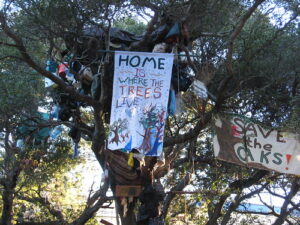 Nevertheless, the students held their ground until 2007, when an Alameda County judge issued an injunction that halted the plans to cut down a grove. It was a temporary “stay of execution” for the trees, but by July 2008, the court decided in favor of the university. Once the decision was made, campus police arrested protesters and dismantled their redwood encampments. There was an appeal, of course, to a state appeals court in September 2008, but they declined to halt construction, permitting the university to remove the entire grove within the next three days. A week later, the last four tree-sitters descended from one of the final two redwoods near the stadium and were arrested. The students had wasted 649 days of their lives, on a battle they couldn’t win. I guess hope springs eternal.
Nevertheless, the students held their ground until 2007, when an Alameda County judge issued an injunction that halted the plans to cut down a grove. It was a temporary “stay of execution” for the trees, but by July 2008, the court decided in favor of the university. Once the decision was made, campus police arrested protesters and dismantled their redwood encampments. There was an appeal, of course, to a state appeals court in September 2008, but they declined to halt construction, permitting the university to remove the entire grove within the next three days. A week later, the last four tree-sitters descended from one of the final two redwoods near the stadium and were arrested. The students had wasted 649 days of their lives, on a battle they couldn’t win. I guess hope springs eternal.
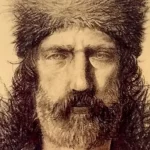
 Being in the fur trade, especially back in the 1800s was no picnic. While the trapper was the one with the traps and the guns, that doesn’t mean that the wild animals couldn’t get the better of them from time to time. In addition, the hardships endured by even the most resilient of trappers, such as being alone in the wilderness and in constant danger of conflict with both wild animals and men, are beyond our ability to comprehend. Most perished in the quiet of remote areas, their names now lost, the valor of their final struggles unrecorded. Only the archives of the major fur companies offer scant references to such events deemed significant enough to document.
Being in the fur trade, especially back in the 1800s was no picnic. While the trapper was the one with the traps and the guns, that doesn’t mean that the wild animals couldn’t get the better of them from time to time. In addition, the hardships endured by even the most resilient of trappers, such as being alone in the wilderness and in constant danger of conflict with both wild animals and men, are beyond our ability to comprehend. Most perished in the quiet of remote areas, their names now lost, the valor of their final struggles unrecorded. Only the archives of the major fur companies offer scant references to such events deemed significant enough to document.
These events typically took place in the great mountains, where trappers held rendezvous and spent the majority of their lives. The catastrophic Battle of Pierre’s Hole, the valiant exploration of Utah, and the initial advance into California are all laden with dramatic episodes. However, these incidents occurred too far to the west to be included in the scope of this current work.
In the initial years of exploration, with beaver trapping along the streams, the Great Plains served primarily as a thoroughfare from civilized regions to the more lucrative mountainous areas beyond. Travelers, whether alone or in groups, journeyed up the Missouri River by boat or trekked along the Platte River valley on foot, aiming for the distant mountain ranges. Undoubtedly, they experienced considerable hardship, adventure, and conflicts with Native Americans along those extensive prairie stretches, yet these events were deemed too mundane to merit inclusion in the fur companies’ matter-of-fact records.
One man had a harrowing experience, and somehow it was deemed important to make it into the annals of history. The remarkable survival of Hugh Glass is a testament to the resilience and fortitude of these frontiersmen. Glass was part of Andrew Henry’s group on an expedition to the Yellowstone River. While hunting near the Grand River, a grizzly bear charged from the brush, knocked him down, ripped a chunk of flesh from him, and fed it to her cubs. Glass attempted to flee, but the bear quickly attacked again, biting his shoulder and causing severe injuries to his hands and arms. At that moment, his fellow hunters arrived and killed the bear. Glass was grievously injured and barely alive. He was not expected to live. In the hostile territory of the Native Americans, the group had to move on swiftly. Eventually, Major Henry persuaded two men to stay with Glass by offering a reward, while the rest continued on. The two were John S Fitzgerald and a man named “Bridges,” who some say was a young James “Jim” Bridger, the same Jim Bridger who would become a renowned trapper. That has not been confirmed. They stayed with Glass for five days, but losing hope in his recovery and seeing no signs of imminent death, they departed, taking his rifle and gear. Upon rejoining their group, they reported Glass as deceased.
Yet, Glass was still alive. Regaining consciousness, he dragged himself to a nearby spring. There, he found wild cherries and buffalo berries, which sustained him as he gradually regained his strength. Eventually, he embarked on a solitary trek to his destination, Fort Kiowa, on the Missouri River, 100 miles distant. He began his journey with barely enough strength to move, without provisions or any means to obtain them, in a land where any wandering Indian could easily overpower him. However, his will to live and a burgeoning desire for vengeance against those who had abandoned him spurred him on. Luck appeared to be on his side. He stumbled upon wolves attacking a buffalo calf. After the wolves had killed it, he scared them off and took the meat, consuming it as best as he could without a knife or fire. Carrying as much as possible, he continued determinedly and, despite immense suffering and difficulties, ultimately arrived at Fort Kiowa, located in what is now South Dakota.
Glass returned to the field before his wounds had fully healed. Heading east with a group of trappers along the Missouri River, they approached the Mandan villages, and he chose to traverse a bend in the river on foot. That turned out to be a wise move when Arikara Indians attacked the boats, killing everyone aboard. Glass, who was too weak to fight, narrowly escaped and was rescued by friendly Mandan Indians who took him to Tilton’s Fort. Driven by a desire for revenge against the two who had abandoned him in the mountains, he left Tilton’s that very night. So, Glass set out, braving the wilderness alone. He traveled for 38 days through territory hostile with Indian tribes, until he arrived at Fort Henry near the confluence of the Big Horn River in what is now Montana. There, he learned that the men he was after had headed east. Undeterred, he seized an opportunity to deliver a dispatch to Fort Atkinson, Nebraska.
Then, after completely healing from his injuries, Glass resumed his quest to locate Fitzgerald and “Bridges.” He made his way to Fort Henry on the Yellowstone River, only to discover it abandoned. A left-behind note revealed that Andrew Henry and his group had moved to a new encampment at the Bighorn River’s mouth. Upon reaching this location, Glass encountered “Bridges” and seemingly pardoned him due to his young age, before rejoining Ashley’s company.
Glass eventually discovered that Fitzgerald had enlisted in the army and was posted at Fort Atkinson, now in Nebraska. Glass chose to spare Fitzgerald’s life, knowing that the army captain would execute him for murdering a fellow soldier. Nevertheless, the captain demanded Fitzgerald return the rifle he had taken from Glass. Upon returning it, Glass cautioned Fitzgerald to never desert the army, or he would face death at Glass’s hands. A later account by Glass’s companion, George C Yount, which wasn’t published until 1923, revealed that Glass received $300 in restitution. I’m sure Fitzgerald felt he got off easy and had no plans to leave the army.

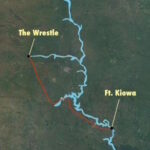 In early 1833, Glass, along with fellow trappers Edward Rose and Hilain Menard, was killed on the Yellowstone River during an Arikara attack. A monument honoring Glass stands near the location of his mauling on the southern bank of what is now Shadehill Reservoir in Perkins County, South Dakota, at the confluence of the Grand River. The adjacent Hugh Glass Lakeside Use Area also offers a state-maintained campground and picnic site at no cost.
In early 1833, Glass, along with fellow trappers Edward Rose and Hilain Menard, was killed on the Yellowstone River during an Arikara attack. A monument honoring Glass stands near the location of his mauling on the southern bank of what is now Shadehill Reservoir in Perkins County, South Dakota, at the confluence of the Grand River. The adjacent Hugh Glass Lakeside Use Area also offers a state-maintained campground and picnic site at no cost.
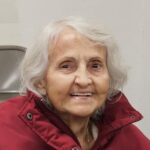
 When my Aunt Sandy Pattan and I go to lunch, she will usually forego vegetables for a double portion of mashed potatoes. Her request will usually accompany her asking me if I know that she is Irish, and so the love of potatoes. Of course, I know that she is Irish, because she is my aunt, and I know about my own Irish ties through her side of the family. Nevertheless, I can’t say that I connected the Irish part with potatoes. So, I decided to do a little research to find our why “the Irish like potatoes” as my aunt says. In my research, I found probably the last thing I expected.
When my Aunt Sandy Pattan and I go to lunch, she will usually forego vegetables for a double portion of mashed potatoes. Her request will usually accompany her asking me if I know that she is Irish, and so the love of potatoes. Of course, I know that she is Irish, because she is my aunt, and I know about my own Irish ties through her side of the family. Nevertheless, I can’t say that I connected the Irish part with potatoes. So, I decided to do a little research to find our why “the Irish like potatoes” as my aunt says. In my research, I found probably the last thing I expected.
In the annals of Irish history, the potato transcends its role as a staple food; it embodies both prosperity and hardship. It was instrumental in supporting the population during times of expansion, yet it also played a pivotal role in one of Ireland’s most catastrophic episodes: the Great Famine. The story of the potato in Ireland  is a tale of how a single crop can influence the fate of a nation, weaving itself into the very fabric of the Irish cultural identity.
is a tale of how a single crop can influence the fate of a nation, weaving itself into the very fabric of the Irish cultural identity.
Few events in Irish history are as dark and devastating as the Great Hunger, also known as the Potato Famine. At that time, Ireland was a colony of Great Britain, which relied heavily on the country for potato production. However, in 1845, a devastating disease destroyed 75% of the potato crop, persisting for over five years. The local Irish population suffered the most. Estimates suggest that approximately one million Irish people died of starvation during the famine and another million emigrated. By the end of the famine in 1852, Ireland’s population had decreased by 25%. The British government faced criticism for its inadequate response, and the catastrophe fueled the drive for Irish independence. The Irish people felt that the British had not tried hard enough to take care of the people under their rule.
As often happens when a food item is no longer allowed or readily available, the Irish people loved their potatoes. The significance of the potato in Irish culture surpasses its agricultural importance, profoundly influencing culinary customs. It turned into a dietary mainstay, with creations like colcannon (mashed potatoes with kale or cabbage), boxty (potato pancakes) being a beloved dish in my Grandma Byer’s (Aunt Sandy’s mom) home, and Irish stew (potatoes, meat, and vegetables) becoming indispensable. These dishes were not 
 merely nourishing but also reflected the creativity and adaptability of Irish cooks who produced a variety of meals from a few ingredients. The simple yet hearty character of these potato-centric dishes mirrored the lives and struggles of ordinary people, ingraining these recipes in the heart of Irish cooking traditions. And with that, I feel like I now understand my aunt’s obsession with potatoes.
merely nourishing but also reflected the creativity and adaptability of Irish cooks who produced a variety of meals from a few ingredients. The simple yet hearty character of these potato-centric dishes mirrored the lives and struggles of ordinary people, ingraining these recipes in the heart of Irish cooking traditions. And with that, I feel like I now understand my aunt’s obsession with potatoes.
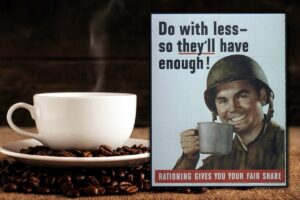
 War usually brings with it, shortages and rationing. On November 29, 1942, coffee was added to the list of rationed items in the United States. Now, people can live without some things, but I would think that coffee would be a really hard item to add to that list. The coffee production in Latin America was at a record, but it made no difference, the increasing demand from military and civilian sectors, along with the pressing needs of shipping for other wartime efforts, necessitated the restriction of its availability.
War usually brings with it, shortages and rationing. On November 29, 1942, coffee was added to the list of rationed items in the United States. Now, people can live without some things, but I would think that coffee would be a really hard item to add to that list. The coffee production in Latin America was at a record, but it made no difference, the increasing demand from military and civilian sectors, along with the pressing needs of shipping for other wartime efforts, necessitated the restriction of its availability.
The truth is that scarcity or shortages were seldom the cause of rationing during the war. Rationing was typically implemented for two main reasons…to ensure an equitable distribution of resources and food to all citizens and to prioritize military needs for certain raw materials in light of the current emergency.
At first, the restriction on the use of certain items was voluntary. People were simply asked to cut back. The problem is that voluntary cutting back seldom works. Also, President Roosevelt initiated “scrap drives” to collect discarded rubber items like old garden hoses, tires, and bathing caps, especially after Japan seized the Dutch East Indies, a key rubber supplier for the United States. These collected items could be exchanged at gas stations for a penny per pound. In the early stages of the war, patriotism and the eagerness to support the war effort was enough.
As US shipping, including oil tankers, became increasingly susceptible to German U-boat attacks, gasoline was the first commodity to be rationed. In seventeen eastern states, car owners were limited to three gallons of gasoline weekly beginning in May 1942. By year’s end, rationing had expanded nationwide, with drivers required to affix ration stamps to their car windshields. Things like butter, were reserved for military use, and so were also rationed. Also limited were coffee, sugar, and milk. In fact, approximately one-third of all food typically consumed by civilians was rationed during the war at some point. We had to make sure our troops had what they needed. They were fighting for our freedom, and we would sacrifice so they could have 
 what they needed. The American people were determined and willing. Of course, that didn’t stop the black market from becoming a source for rationed items, selling goods at prices above those set by the Office of Price Administration to Americans who could afford the marked-up costs. Nevertheless, certain items were removed from the rationing list ahead of time; coffee became available in July 1943, but sugar remained rationed until June 1947.
what they needed. The American people were determined and willing. Of course, that didn’t stop the black market from becoming a source for rationed items, selling goods at prices above those set by the Office of Price Administration to Americans who could afford the marked-up costs. Nevertheless, certain items were removed from the rationing list ahead of time; coffee became available in July 1943, but sugar remained rationed until June 1947.

